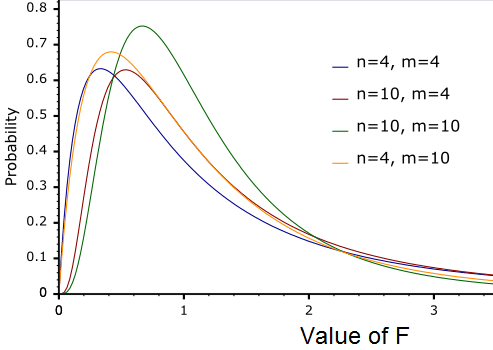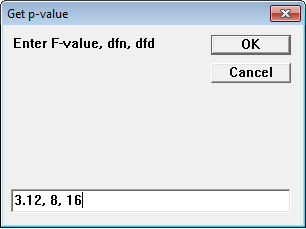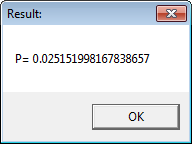F-distribution
In probability theory and statistics, the F-distribution is a continuous probability distribution. The F-distribution arises frequently as the null distribution of a test statistic.
 An F-test is any statistical test in which the test statistic has an F-distribution under the null hypothesis. A common use of F-tests is in the analysis of variance (ANOVA).
An F-test is any statistical test in which the test statistic has an F-distribution under the null hypothesis. A common use of F-tests is in the analysis of variance (ANOVA).
The cumulative F-distribution can be obtained using the regularized incomplete beta function with the following inputs: X = d1 * F / (d1 * F + d2), a = d1 / 2, and b = d2 / 2, where F is the value obtained in the F-test, d1 is the degrees of freedom for the numerator, and d2 is the degrees of freedom for the denominator.
The source code below applies that method to estimate the probability of the null hypothesis for a given F-value.
[code language="vb"]
#COMPILE EXE
#REGISTER NONE
#DIM ALL
'
FUNCTION PfromF(BYVAL F AS EXT,BYVAL dfn AS EXT,BYVAL dfd AS EXT) AS EXT
LOCAL ifault AS LONG, Beta, betain AS EXT
IF F > 0.0 AND dfn > 0.0 AND dfd > 0.0 THEN
CALL IncomplBeta(dfd/(dfd + dfn * F),dfd * 0.5, dfn * 0.5, Beta, betain)
FUNCTION = betain
ELSE
FUNCTION = 1.0
END IF
END FUNCTION
'
FUNCTION PBMAIN
LOCAL Result AS STRING, i1, i2 AS LONG
LOCAL P, F, dfn, dfd AS EXT
Result$ = INPUTBOX$("Enter F-value, dfn, dfd","Get p-value")
i1 = INSTR(Result$, ",")
i2 = INSTR(i1 + 1,Result, ",")
F = VAL(LEFT$(Result, i1 - 1))
dfn = VAL(MID$(Result, i1 + 1,i2 - i1 - 1))
dfd = VAL(MID$(Result,i2 + 1))
P = PfromF(F, dfn, dfd)
MSGBOX "P=" + FORMAT$(P," ##.##################"),,"Result:"
END FUNCTION
'
SUB IncomplBeta(BYVAL X AS EXT, BYVAL P AS EXT, BYVAL Q AS EXT, _
BYREF beta AS EXT, BYREF betain AS EXT)
'
' Derived from FORTRAN code based on:
' algorithm AS 63 Appl. Statist. (1973), vol.22, no.3
' Computes incomplete beta function ratio for arguments
' X between zero and one, p (=a) and q (=b) positive.
' Returns log beta and Regularized Incomplete Beta
'
LOCAL ns, indx AS LONG
LOCAL zero, one, acu AS EXT
LOCAL psq, cx, xx, pp, qq, term, ai, rx, temp AS EXT
' define accuracy and initialise
zero = 0.0 : one = 1.0 : acu = 1.0E-18
betain = 0.0 : beta = 0.0
' test for admissibility of arguments
IF(p <= zero OR q <= zero) THEN EXIT SUB
IF(x < zero OR x > one) THEN EXIT SUB
IF(x = zero OR x = one) THEN EXIT SUB
' calculate log of beta by using function GammLn
beta = gammln(p) + gammln(q) - gammln(p + q)
betain = x
' change tail if necessary
psq = p + q
cx = one - x
IF (p < psq * x) THEN
xx = cx
cx = x
pp = q
qq = p
indx = 1
ELSE
xx = x
pp = p
qq = q
indx = 0
END IF
term = one
ai = one
betain = one
ns = qq + cx * psq
' use Soper's reduction formulae.
rx = xx / cx
temp = qq - ai
IF (ns = 0) THEN rx = xx
DO
term = term * temp * rx / (pp + ai)
betain = betain + term
temp = ABS(term)
IF(temp <= acu AND temp <= acu * betain) THEN EXIT DO
ai = ai + one
ns = ns - 1
IF (ns >= 0) THEN
temp = qq - ai
IF (ns = 0) THEN rx = xx
ELSE
temp = psq
psq = psq + one
END IF
LOOP
' calculate Regularized Incomplete Beta
betain = betain * EXP(pp * LOG(xx) + (qq - one) * LOG(cx) - beta) / pp
IF indx = 1 THEN betain = one - betain
END SUB
'
FUNCTION GammLn(BYVAL x AS EXT) AS EXT
' Returns Ln(Gamma()) or 0 on error
' Based on Numerical Recipes gamma.h
' Lanczos, C. 1964, "A Precision Approximation
' of the Gamma Function," SIAM Journal on Numerical
' Analysis, ser. B, vol. 1, pp. 86-96.
LOCAL j AS LONG, tmp, y, ser AS EXT
DIM cof(0 TO 13) AS LOCAL EXT
cof(0) = 57.1562356658629235
cof(1) = -59.5979603554754912
cof(2) = 14.1360979747417471
cof(3) = -0.491913816097620199
cof(4) = 0.339946499848118887e-4
cof(5) = 0.465236289270485756e-4
cof(6) = -0.983744753048795646e-4
cof(7) = 0.158088703224912494e-3
cof(8) = -0.210264441724104883e-3
cof(9) = 0.217439618115212643e-3
cof(10) = -0.164318106536763890e-3
cof(11) = 0.844182239838527433e-4
cof(12) = -0.261908384015814087e-4
cof(13) = 0.368991826595316234e-5
IF x <= 0.0 THEN FUNCTION = 0.0 : EXIT FUNCTION ' Bad argument
y = x
tmp = x + 5.2421875
tmp = (x + 0.5) * LOG(tmp) - tmp
ser = 0.999999999999997092
FOR j = 0 TO 13
y = y + 1
ser = ser + cof(j)/y
NEXT j
FUNCTION = tmp + LOG(2.5066282746310005 * ser / x)
END FUNCTION
[/code]




